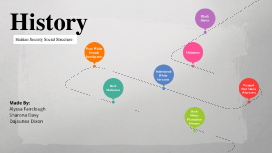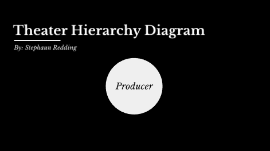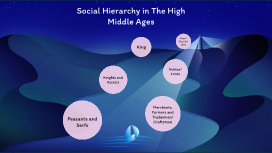Theatre Hierarchy Diagram
Transcript: Theater Hierarchy Diagram By: Stephaun Redding Producer Producer a person responsible for the financial and managerial aspects of making of a movie or broadcast or for staging a play, opera, Director Director person who supervises the actors, camera crew, and other staff for a movie, play, television program, or similar production. Music Director Music Director responsible for working with the stage director in preparing a theatre production for public performance, including casting, rehearsing the vocalists and orchestra, and conducting (and sometimes selecting) the orchestra. Choreographer Choreographer one who creates choreographs by practicing the art of choreography, a process known as choreographing Dance Captain Dance Captain a member of a company (ensemble/Dancers/Performers) who is responsible for overseeing and maintaining the artistic standards of all choreography and musical staging within a production Conductor Conductor a person who directs the performance of an orchestra or choir Musicians Musicians a person who plays a musical instrument, especially as a profession, or is musically talented Assistant Director Assistant Director a film includes tracking daily progress against the filming production schedule, arranging logistics, preparing daily call sheets, checking cast and crew, and maintaining order on the set. They also have to take care of the health and safety of the crew. Actors Actors a person whose profession is acting on the stage, in movies, or on television. Tech Director Tech Director is responsible for purchasing construction materials, supervising the building of scenery, transporting set pieces from the shop to the theatre stage, mounting the scenery onstage, overseeing the work of the scenic crews during rehearsals and performances, and maintaining the shop’s equipment and supplies. Stage Manager Stage Manager the person responsible for the lighting and other technical arrangements for a stage play. Assistant Stage Manager Assistant Stage Manager catchall, a go-to person who answers all calls for help. During the run of the show, the ASM is assigned a specific track that may include performing pre-show checks and setting props or costumes. Special Effects Special Effects an illusion created for movies and television by props, camerawork, computer graphics, etc Stage Crew Head Stage Crew Head responsible for overseeing the backstage operation, maintenance and repair of our theatrical productions, programs, etc.. Stage Crew crew of workers who move scenery or handle properties in a theatrical production Rigger/Grip one who works on ropes, booms, lifts, hoists and the like for a stage production, film, or television show Runner assist wherever they are needed on productions and their duties vary depending on where they are assigned Makeup Crew an artist whose medium is the human body, applying makeup and prosthetics on others for theatre, television, film, fashion, magazines and other similar productions including all aspects of the modeling industry. Makeup Designer Makeup Designer responsible for the visual appearance of any makeup worn by the actors Props Designer Props Designer a person who designs props for use in theatre, film, television, etc Costume Designer Costume Designer a person who designs costumes for a film, stage production or television show. they also have to create the characters' outfits/costumes and balance the scenes with texture and colour, etc Sound Designer Sound Designer responsible for obtaining all sound effects, whether recorded or live for a specific production Lighting Designer Lighting Designer responsible for the design, installation, and operation of the lighting and special electrical effects used in the production Set Designer Set Designer someone who is in charge of designing and creating sets for films, television, and theatre (sets are the physical surroundings in which all the action will take place during the production) Artistic Director Artistic Director the executive of an arts organization, particularly in a theatre or dance company, who handles the organization's artistic direction Vocal Director Vocal Director responsible for working with the stage director in preparing a theatre production for public performance, including casting, rehearsing the vocalists and orchestra, and conducting (and sometimes selecting) the orchestra. House Manager House Manager responsible for the smooth operation of the house (typically both the lobby and audience seating area) during the run of the show Ushers Ushers a person who shows people to their seats, especially in a theater Publicity/ Marketing Manager Publicity/ Marketing Manager work with individuals and companies in an attempt to help them earn favorable press in the media

















